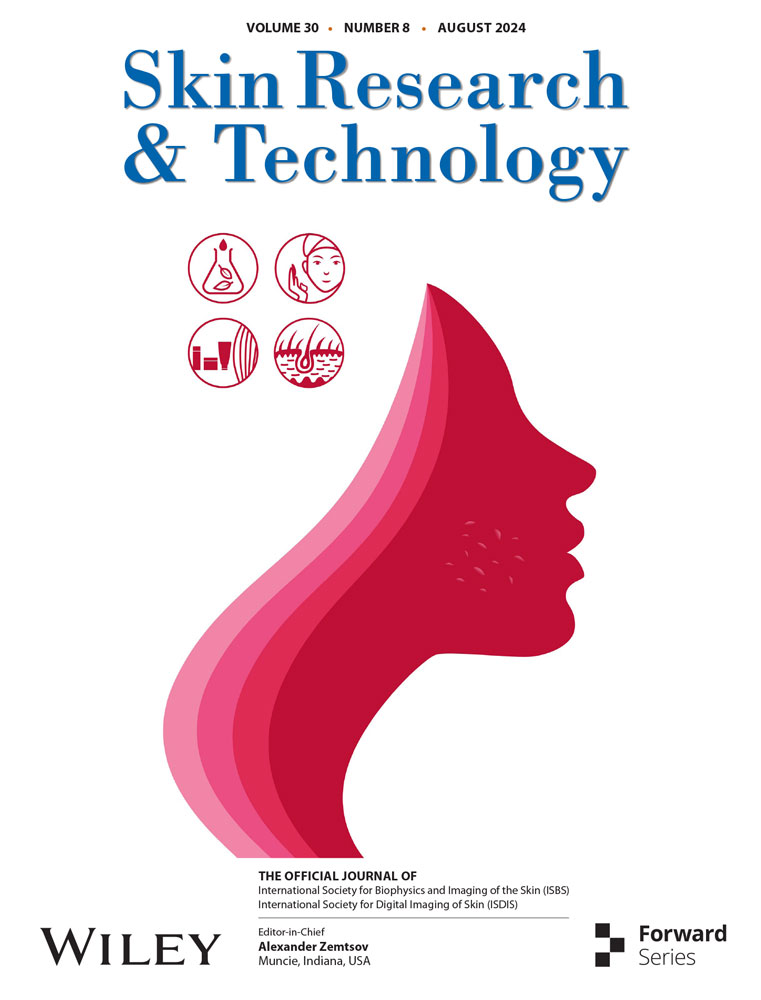Exploring the landscape of extracellular vesicle application for skin and plastic surgery: A bibliometric analysis from 2003 to 2023
Qian Liu, Hao Zhang, and Yanan Zhu have contributed equally to this work.
Abstract
Background
Exosomes and other secretory membrane vesicles, collectively referred to as extracellular vesicles (EVs), have garnered increasing attention in research due to their biological characteristics. Notably, studies have shown promising results regarding the role of stem cell-derived extracellular vesicles (SC-EVs) in skin and plastic surgery applications. This study aims to elucidate current trends in SC-EVs within the context of skin and plastic surgery and offer insights for future research directions in advancing this critical field.
Methods
A comprehensive search was conducted for relevant studies on SC-EVs in skin and plastic surgery spanning from 2003 to 2023, utilizing the Web of Science database. Subsequently, data analysis was performed using VOSviewer and CiteSpace.
Results
A total of 1089 studies were identified, with a noticeable annual increase in publications on SC-EVs' application in skin and plastic surgery. China emerged as the leading contributor to this field, with Shanghai Jiao Tong University being a notable institution. Stem Cell Research & Therapy and the International Journal of Molecular Sciences were the top journals publishing relevant articles. Author Fu Xiaobing from the Chinese People's Liberation Army General Hospital had the highest publication count in this area. Keyword co-occurrence analysis revealed six distinct clusters, with “exosomes” being the most prevalent keyword in recent years. Wound healing and skin rejuvenation emerged as primary research focuses and hotspots in this field.
Conclusion
This comprehensive review offers insights into global trends surrounding SC-EVs in skin and plastic surgery. Analysis of journals, institutions, references, and keywords provides valuable guidance for researchers in determining future research directions.
1 INTRODUCTION
Extracellular vesicles (EVs), nanoscale lipid bilayer particles, are secreted by virtually all cell types into the extracellular environment.1 They are classified according to biological origin and size into three main types: exosomes, microvesicles, and apoptotic bodies.2 Exosomes originate from the fusion and release of multivesicular bodies (MVBs) that bud inward from cell membrane. Microvesicles are directly shed from the cell membrane, whereas apoptotic bodies are produced through caspase-mediated programmed cell death.3
Owing to their exceptional biocompatibility, inclination for cellular internalization, and precision in tissue targeting,4 EVs, notably exosomes, have risen to prominence in the cutting-edge arenas of plastic surgery and cosmetic dermatology, including repair and regeneration of skin, soft tissues, and bone, and even the management of breast cancer.5-7
Literature serves as a chronicle of scientific advancements. As a cornerstone of analytical study, bibliometrics furnishes us with a quantitative toolkit for the systematic assessment and scrutiny of literature within delineated academic domains.8 It offers a sweeping vista that encapsulates a wealth of specific details, including geographical origins, institutional affiliations, journal sources, bibliographic references, and keyword trends. By tapping into contemporary computational capabilities, the integration of graphical and visual representations has significantly enriched the depth of bibliometric analysis, enabling a more nuanced and profound comprehension of the data.9
To addresses a significant research gap, our study conducted a thorough bibliometric analysis of publications concerning stem cell-derived extracellular vesicles (SC-EVs) and skin and plastic surgery, drawing from the Web of Science database spanning from 2003 to 2023. Through an examination of key metrics, this research offers valuable insights into the present landscape of investigation within this domain. Moreover, it identifies promising directions for future research endeavors, thereby contributing to the advancement of knowledge in this field.1
2 MATERIALS AND METHODS
2.1 Data sources and search strategy
The search strategy and screening process are presented in Figure 1. All data were obtained from the Web of Science Core Collection (WoSCC) on May 10, 2024, with all searches conducted concurrently to mitigate potential bias stemming from daily database updates. The search formula is (TS = (stem cell*) OR TS = (SC) OR TS = (SCs) OR TS = (MSC*) OR TS = (Mesenchymal stem cell*)) AND TS = (“extracellular vesicle*” OR “EV” OR “EVs” OR “exosome*” OR “microvesicle*” OR “shed microvesicle*” OR “small microvesicle* ”OR “sMV*”) AND (TS = (skin) OR TS = (Dermatology) OR TS = (Dermatologic Surgical Procedure*) OR TS = (Procedure*, Dermatologic Surgical) OR TS = (Surgical Procedure*,Dermatologic) OR TS = (Cutaneous* Surgical Procedures) OR TS = (Procedure*,Cutaneous Surgical OR TS = (Surgical Procedure*,Cutaneous OR TS = (Skin Surger*) OR TS = (Surger*,Skin) OR TS = (Cutaneous Surger*) OR TS = (Surger*,Cutaneous OR TS = (Dermatologic Surger* OR TS = (Surger*,Dermatologic OR TS = (Surger*, Plastic) OR TS = (Plastic Surger*) OR TS = (Esthetic Surger* OR TS = (Surger*, Esthetic OR TS = (Surger*,Cosmetic) OR TS = (Cosmetic Surger*) OR TS = (Wound Healing*) OR TS = (Healing*, Wound) OR TS = (Re-Epithelialization) OR TS = (Wound Epithelialization) OR TS = (Epithelialization, Wound)) AND (DOP = (2003-01-01/2023-12-31)). Excluded documents included Meeting Abstract, Early Access, Book Chapters, Correction, Editorial Material, Proceeding Paper, Retracted Publication, Data Pape, Letter, and Retraction. And the language of studies was limited to English.
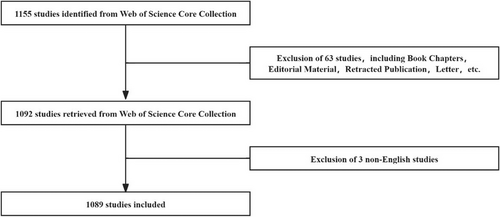
2.2 The bibliometric analysis method
Our study adopted a comprehensive methodology for data extraction from the Web of Science database. To preliminarily analyze the trends of SC-EVs for skin and plastic surgery, Microsoft Excel was used for initial visualization of the data. Then, we conducted a further bibliometric analysis of the aforementioned data from perspectives including the country, institution, journal, author, specific literature, and keywords with the aid of VOSviewer and CiteSpace software, providing a more in-depth understanding of the research landscape and identifying key players and research topics in the field. Additionally, Scimago Graphica was also utilized for data visualization purposes. To ensure the assessment of journal quality and influence, the latest edition (2022) of the Journal Citation Reports (JCR) was also referenced to obtain up-to-date impact factors (IF) for relevant journals.
3 RESULTS
3.1 Global publishing trends
According to our search strategy, there were a total of 1089 studies on the roles of EVs in skin and plastic surgery in the past two decades. These inclusions of 1089 articles indicate a substantial body of research on this topic. The number of publications from 2003 to 2018 grew slowly and was relatively low (Figure 2A). However, it increased dramatically from 2019 to 2023, highlighting the area's high value and rapid expansion of research.

3.2 Countries distribution analysis
A total of 1089 research articles from 60 countries were analyzed, illustrating the widespread global interest in the research area. Table 1 lists the number of publications, citations, and other relevant data from the top 10 productive countries in this field. China was the most prolific contributor, with 578 publications, which is 53.08% of the total. This significant contribution underscores China's dominant role in propelling research in this field. USA followed with 164 publications, accounting for 15.05% of the total. The substantial input from the USA also highlights its important role in these research endeavors. And South Korea contributed 67 publications (6.15%), Iran and Italy each contributed 48 publications (both 4.41%). These figures point to the active participation of these countries in the research domain. In terms of citation counts, China leads with a significant margin at 20 238 citations, followed by the United States with 7066 citations and Iran with 1895 citations (Table 1). These numbers indicate not only the volume of work produced by these countries but also their influence in the scientific community. From the point of view of the concentrated time of the article, countries in purple (like Germany and France) have a historical depth in publications predating 2020 (Figure 2B). Countries in green (such as China, the USA, and Iran) experienced a surge in publication output from 2020 to 2022. Countries in yellow (including Malaysia, Indonesia, and the Netherlands) showed an increase in publications post-2022. This color-coded mapping helps in understanding the temporal distribution and evolution of research activities across different regions.
| Country | Publications | Citations | Average citation rate | % of (Publications) |
|---|---|---|---|---|
| China | 578 | 20 238 | 35.0 | 53.08 |
| United States | 164 | 7066 | 43.1 | 15.05 |
| South Korea | 67 | 1780 | 25.6 | 6.15 |
| Iran | 48 | 1895 | 39.5 | 4.41 |
| Italy | 48 | 1432 | 29.8 | 4.41 |
| Germany | 34 | 1686 | 49.6 | 3.12 |
| United Kingdom | 34 | 595 | 17.5 | 3.12 |
| Japan | 30 | 487 | 16.2 | 2.75 |
| France | 26 | 804 | 30.9 | 2.39 |
| India | 22 | 530 | 24.1 | 2.02 |
In addition to publications, potential collaborations between individual countries are also worth noting; China and the United States have the closest international cooperation on relevant research (Figure 2C and 2D). And some major cooperative groups have been formed in the world (Figure 2E). On the density map, the arresting group of cooperation was the China- focused group, which was formed as a collaboration between many countries, including United States, South Korea, Canada, and Iran, demonstrating a robust network of international research partnerships.
3.3 Institutional distribution analysis
The top five productive institutions contributing to research on the roles of EVs in skin and plastic surgery are all located in China (Table 2). Leading the pack is Shanghai Jiao Tong University, producing a total of 39 publications, followed closely by Huazhong University of Science and Technology with 34 publications, Fourth Military Medicine University with 31 publications, Sichuan University with 30 publications, and Sun Yat-Sen University with 28 publications. In terms of citations received, Shanghai Jiao Tong University leads with an impressive count of 2472 citations, followed by Fourth Military Medicine University with 1579 citations, and Huazhong University of Science and Technology with 1526 citations (Table 2).
| Institutions | Publications | Citations | Average citation rate |
|---|---|---|---|
| Shanghai jiao tong univ | 39 | 2472 | 63.4 |
| Huazhong univ sci &technol | 34 | 1562 | 46.0 |
| Fourth mil med univ | 31 | 1579 | 50.9 |
| Sichuan univ | 30 | 622 | 20.7 |
| Sun yat sen univ | 28 | 849 | 30.3 |
| Southern med univ | 19 | 561 | 29.5 |
| Chniese peoples liberat army gen… | 18 | 1040 | 57.8 |
| Fudan univ | 18 | 382 | 21.2 |
| Cent south univ | 18 | 271 | 15.1 |
| Zhejiang univ | 17 | 734 | 43.2 |
Further analysis utilizing was conducted to explore more potential information. Employing a threshold of 10 documents, the analysis identified the top 32 institutions meeting this criterion, which were then visualized in a time overlay map based on the concentration of their publications by year (Figure 3A). This analysis revealed that Shanghai Jiao Tong University exhibited a concentration of publications in 2020, while Huazhong University of Science and Technology, Fourth Military Medicine University, Sichuan University, and Sun Yat-Sen University predominantly published after 2021. Moreover, cluster density maps based on bibliographic coupling and co-authorship analysis were utilized to demonstrate the thematic relevance and cooperation situation between them, respectively (Figure 3B, C). These visualizations provide insight into the interconnectedness and thematic focus of research efforts across these institutions.
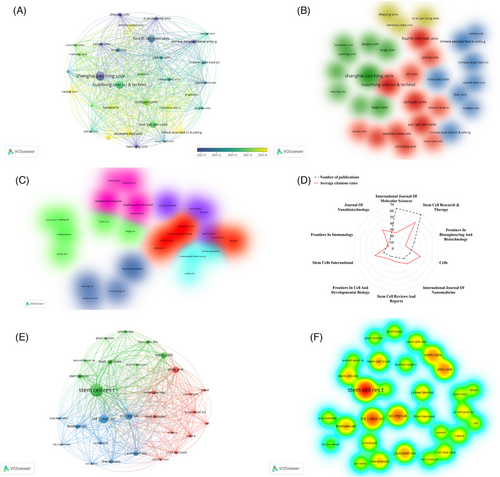
3.4 Journal distribution analysis
Analyzing the distribution of journals provides insight into the prominent publications within the realm of EVs applications for skin and plastic surgery. A radar map was utilized to depict the 10 most prolific journals in terms of publication count and Stem Cell Research & Therapy (Impact Factor [IF] = 7.50, 2023) and the International Journal of Molecular Sciences (IF = 5.60, 2023) stand out with 67 and 64 publications, respectively (Figure 3D).
Subsequently, an examination of journal contributions was undertaken to elucidate the interconnections between these referenced journals. The top 30 referenced journals are depicted in a network, with a units’ density map visualization showcasing all referenced journals (Figure 3E, F). Stem Cell Research & Therapy and the International Journal of Molecular Sciences emerge as primary publishing hubs, characterized by strong links (according to the number of lines between the units, Figure 3E) to other journals and high citations (according to the unit's density, Figure 3F), underscoring their pivotal roles in disseminating research findings and shaping the research agenda in this field. Consequently, these journals are poised to maintain their significance as key outlets for scholarly discourse and dissemination of knowledge in the foreseeable future.
3.5 Analysis of authors contributions
Analyzing the authors of scholarly literature is crucial for identifying prominent scholars and core research contributors within a given field. According to the average citation volume of the top 10 authors (Figure 4A), Zhang Bin leads the pack with an average of 181.5 citations per publication across 11 publications. Following closely behind are Qian Hui with an average of 163.3 citations per publication over 8 publications, and Wang Yang with an average of 144.7 citations per publication across 10 publications. Among highly prolific authors, one stands out with the highest number of publications—Fu Xiaobing. This distinguished scholar, a member of the Chinese Academy of Engineering, has held a longstanding position at the Chinese People's Liberation Army General Hospital. Since 2003, they have contributed to the academic discourse with a total of 12 papers. A comprehensive review of existing literature unmistakably indicates that this scholar's primary research focus revolves around the domain of “trauma and tissue repair and regeneration,” especially diabetic wound.10-13 Notably, all scholars mentioned above are Chinese, a trend consistent with the dominance of Chinese institutions highlighted in the earlier analysis (Tables 1 and 2). This underscores the significant contributions of Chinese scholars to the advancement of knowledge in this field.
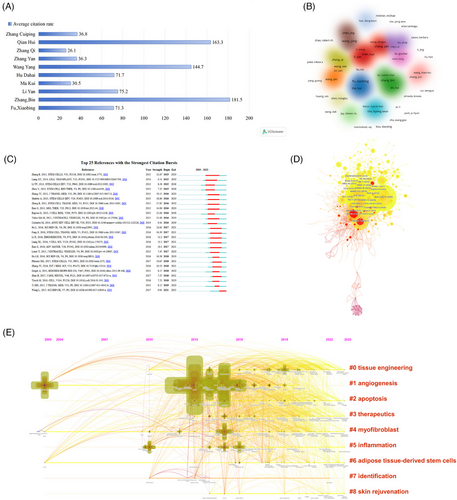
Further analysis, employing a threshold of at least four documents per author, revealed a total of 126 authors making substantial contributions to the field. These highly productive authors have coalesced into several collaborative groups, as depicted in Figure 4B. This collaborative network sheds light on the synergistic efforts of researchers driving advancements in SC-EV research for skin and plastic surgery.
3.6 Analysis of reference contributions
The top 10 most-cited publications in the realm of SC-EVs application for skin and plastic surgery are listed in Table 3. Notably, these publications were predominantly released in 2015 and 2016, indicating a surge of interest and research activity during that period. Among the top 10 publications, “HucMSC-Exosome Mediated-Wnt4 Signaling Is Required for Cutaneous Wound Healing” stands out with the highest citation count (554). This research, published in Stem Cells (IF = 5.2), underscores the importance of exosome-mediated signaling pathways in wound healing processes.14 Another noteworthy publication among them is the latest study titled “Engineering Bioactive Self-Healing Antibacterial Exosomes Hydrogel for Promoting Chronic Diabetic Wound Healing and Complete Skin Regeneration.” Published in Theranostics (IF = 12.4, the highest one in those journals), this research introduces innovative approaches to chronic wound treatment and skin regeneration using engineered exosome-loaded hydrogels.5 Despite the notable advancements, there are still opportunities for further innovation and exploration within the field of SC-EVs application for skin and plastic surgery.
| Title | Corresponding authors | Journal | IF (2023) | Publication year | Total citations |
|---|---|---|---|---|---|
| HucMSC-Exosome Mediated-Wnt4 Signaling Is Required for Cutaneous Wound Healing | Wenrong Xu | Stem Cells | 5.2 | 2015 | 554 |
| Exosomes released from human induced pluripotent stem cells-derived MSCs facilitate cutaneous wound healing by promoting collagen synthesis and angiogenesis | Yang Wang | Journal of Translational Medicine | 7.4 | 2015 | 505 |
| Engineering Bioactive Self-Healing Antibacterial Exosomes Hydrogel for Promoting Chronic Diabetic Wound Healing and Complete Skin Regeneration | Cong Mao | Theranostics | 12.4 | 2019 | 503 |
| The Landscape of MicroRNA, Piwi-Interacting RNA, and Circular RNA in Human Saliva | Xinshu Xiao | Clinical Chemistry | 9.3 | 2015 | 503 |
| Tumor-associated stromal cells as key contributors to the tumor microenvironment | Frank C. Marini | Breast Cancer Research volume | 5.7 | 2016 | 502 |
| Mesenchymal Stem Cells Secrete Immunologically Active Exosomes | Sai Kiang Lim | Stem Cells and Development | 4.0 | 2014 | 496 |
| Mesenchymal Stem Cell Exosomes Induce Proliferation and Migration of Normal and Chronic Wound Fibroblasts, and Enhance Angiogenesis In Vitro | Evangelos Van Badiavas | Stem Cells and Development | 4.0 | 2015 | 462 |
| LPS-preconditioned mesenchymal stromal cells modify macrophage polarization for resolution of chronic inflammation via exosome-shuttled let-7b | Weidong Han | Journal of Translational Medicine | 7.4 | 2015 | 450 |
| Exosomes secreted by mesenchymal stem cells promote endothelial cell angiogenesis by transferring miR-125a | Robert Chunhua Zhao | Journal of Cell Science | 4.0 | 2016 | 390 |
| Umbilical Cord-Derived Mesenchymal Stem Cell-Derived Exosomal MicroRNAs Suppress Myofibroblast Differentiation by Inhibiting the Transforming Growth Factor-β/SMAD2 Pathway During Wound Healing | Xin Xing | Stem Cells Translational Medicine | 6.0 | 2016 | 367 |
Utilizing CiteSpace, the top 25 references with the strongest citation bursts offer valuable insights into evolving research trends and hot topics (Figure 4C). By conducting burst analysis on references, researchers can identify emerging areas of interest and innovation within the SC-EVs research landscape for skin and plastic surgery. Then, a co-citation network of references was analyzed, providing insights into the interconnectedness of key research works (Figure 4D). This visualization aids in understanding the foundational literature and influential works shaping the field. The title cluster analysis categorizes references into eight distinct clusters, revealing emerging themes in SC-EVs research, including tissue engineering, angiogenesis, apoptosis, therapeutics, myofibroblast, inflammation, adipose tissue-derived stem cells, identification, and skin rejuvenation (Figure 4E). The clustering display of the timeline further highlights shifts in research focus over time, from earlier emphasis on angiogenesis to recent interests in apoptosis, inflammation, tissue engineering, and skin rejuvenation. Notably, myofibroblast and adipose tissue-derived stem cells have consistently remained research hotspots within the field, indicating their enduring significance in SC-EVs application for skin and plastic surgery. Overall, this comprehensive analysis provides valuable insights into the past, present, and future trajectories of SC-EVs research in the context of skin and plastic surgery, guiding researchers toward areas of critical importance and potential innovation.
3.7 Analysis of keywords
Keywords play a pivotal role in discerning the central themes of publications. Through keyword co-occurrence analysis, a systematic understanding of the current progress and trending topics in the utilization of SC-EVs in skin and plastic surgery, along with their intrinsic interconnections, can be attained. Notably, the prominence and significance of keywords are depicted through their size, color, and density within visual representations (Figure 5A, B). Different colors represent distinct clusters of models related to SC-EVs and the skin and plastic surgery, such as “exosomes” in red, “wound healing” in pink, “extracellular vesicle” and “mesenchymal stem cells” in purple, “angiogenesis” in yellow, “stem cell” in blue, and “therapy” in green, collectively outlining the primary research directions in SC-EV application for skin and plastic surgery (Figure 5A). Among these keywords, “exosomes” stood out with the highest frequency and link strength, underscoring the significance and expansive potential of exosomes in the realm of EVs for skin and plastic surgery. Furthermore, the top 10 keywords exhibiting the strongest citation bursts are highlighted, underscoring evolving areas of focus (Figure 5C). Early burst keywords like “TGF-β,” “microvesicle,” “microRNA,” and “stromal cell” have sustained high attention, while others like “enhance angiogenesis” and “myocardial infarction” suggest expanding applications of SC-EVs beyond traditional boundaries. Additionally, the time overlay map also reveals a gradual shift from fundamental research, such as stromal cells and mesenchymal stem cells, toward clinical applications like wound healing and hydrogel (Figure 5D). Correspondingly, timeline analysis echoes these trends, highlighting research hotspots and directions such as endothelial cells, biomaterials, skin rejuvenation, fibrosis, ASC-exosome, and tumor microenvironment (Figure 5E).
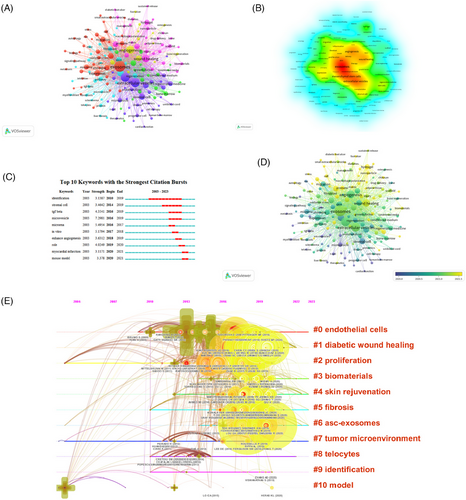
4 DISCUSSION
EVs represent nanoscale lipid bilayer particles discharged into the extracellular milieu by virtually all cell types, containing proteins, lipids, DNA, and RNA.1, 4 By transporting bioactive molecules, EVs regulate various cellular processes, influencing cell proliferation, differentiation, immune responses, and tissue repair.15 Their ability to cross biological barriers and target specific cells makes EVs pivotal in physiological and pathological events, with significant applications in clinical medicine, particularly in dermatology and plastic surgery.16, 17 There have been more and more reports on the application of EVs in skin and plastic surgery in recent years.11, 18 In order to explore the landscape of SC-EV research for skin and plastic surgery, this study conducted the first bibliometric analysis of publications on this topic.
The bibliometric techniques, such as VOSviewer and CiteSpace, were utilized for constructing knowledge maps. VOSviewer uses probabilistic normalization to create varied visualizations including keywords, offering clear and graphic-rich displays.19, 20 Owing to their versatility and robust methodology, bibliometrics has become integral to the assessment and forecasting of emerging or potential trends within the medical domain.21, 22
Through a meticulously crafted search formula applied to the Web of Science (WOS) database, this study comprehensively collected literature on the application of SC-EVs in dermatology and plastic surgery from 2003 to 2023. A marked increase in related research has been observed in recent years. China leads in both the volume of publications and citation counts, indicating its significant impact in this domain. Among the academic institutions, Shanghai Jiao Tong University stands out for its exceptional contributions. Subsequently, our research analyzed the journals publishing the relevant literature. Among numerous journals, “Stem Cell Research & Therapy” and the “International Journal of Molecular Sciences” merit particular attention. The analysis of author contributions revealed Fu Xiaobing as a scholar with substantial influence in the field, dedicated to research on trauma and tissue repair and regeneration.10, 13 To identify the latest trends in SC-EVs and research related to dermatology and plastic surgery, we conducted title cluster analysis and keyword co-occurrence cluster analysis of references. These analyses help to outline emerging themes and focal areas within the scholarly discourse, thereby enhancing our comprehension of the current research trajectory in this field. The results indicate a clear focus among researchers on the application of SC-EVs in wound healing and skin rejuvenation.
4.1 Would healing
Wound repair constitutes a multifaceted physiological mechanism wherein organisms react to tissue damage.23 It intricately intertwines with inflammation, cell migration recruitment, angiogenesis, matrix deposition, new tissue generation, and wound closure, orchestrated by a myriad of cell types and molecular cues.24 Dysregulated factors above within this intricate repair process frequently culminate in inadequate healing.25 Annually, millions worldwide suffer from compromised wound healing subsequent to trauma, surgical interventions, acute illnesses, or chronic conditions.26 Due to the biological properties of EVs, particularly exosomes, there is a broad potential for their involvement in angiogenesis and wound healing.3, 27 In recent years, there has been a growing volume of research focused on elucidating the mechanisms28, 29 by which EVs facilitate wound healing, as well as exploring the application of EVs in conjunction with other biomaterials for targeted clinical interventions.30
4.2 Skin rejuvenation
Skin rejuvenation encompasses various objectives, including scar reduction, anti-aging, and anti-pigmentation strategies. EVs have garnered significant interest within the skin rejuvenation domain due to their nanoscale dimensions and favorable biocompatibility, offering the potential for achieving facial enhancement with minimal tissue disruption.31 In recent years, research on EVs, particularly exosomes, has experienced significant advancements in understanding the mechanisms underlying skin rejuvenation, including fibroblasts,32 MMPs,33 ROS.34 Moreover, there is a burgeoning interest in developing novel applications for EVs in this context.35, 36
While research and applications involving EVs in humans have progressed rapidly, yielding notable achievements, there remains a need for further exploration into the mechanisms governing EVs and their scalability for production, issues surrounding stable storage and so on. In conclusion, the translation of these findings into clinical practice warrants continued investigation.
5 LIMITATIONS
This paper acknowledges limitations, particularly the variability in citation practices across different fields and countries, which may affect the equity and outcomes of bibliometric analyses. Additionally, the time lag between publication and citation could impede the identification of current research trends.
6 CONCLUSION
Our study delivers an exhaustive analysis of global productivity and collaboration patterns, core journals, and the nascent trends involving the use of SC-EVs across various dermatological and plastic surgical contexts. The continuous expansion of research impact highlights the growing significance of SC-EVs in medical innovation. Looking forward, future research should prioritize the exploration of the therapeutic potentials of SC-EVs, especially in conditions like wound healing or skin rejuvenation, and should also delve into the standardized applications of SC-EVs. Such efforts could catalyze advancements in EV-based therapies and potentially spur the development of the medical aesthetics industry.
CONFLICT OF INTEREST STATEMENT
All authors state that the research was conducted in the absence of any commercial or financial relationships that could be construed as a potential conflict of interest.
ETHICS STATEMENT
The authors declare human ethics approval was not needed for this study.
Open Research
DATA AVAILABILITY STATEMENT
All data generated or analyzed during this study are included in this article. Further inquiries can be directed to the corresponding author.



